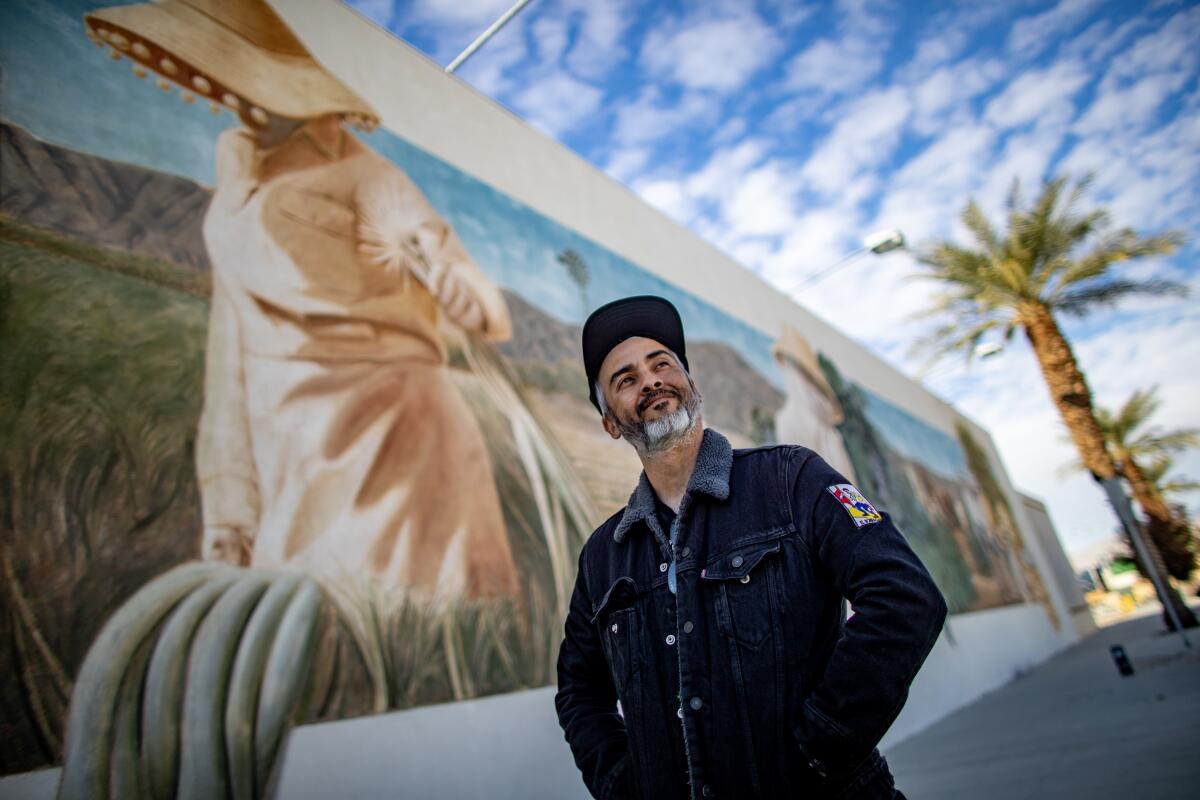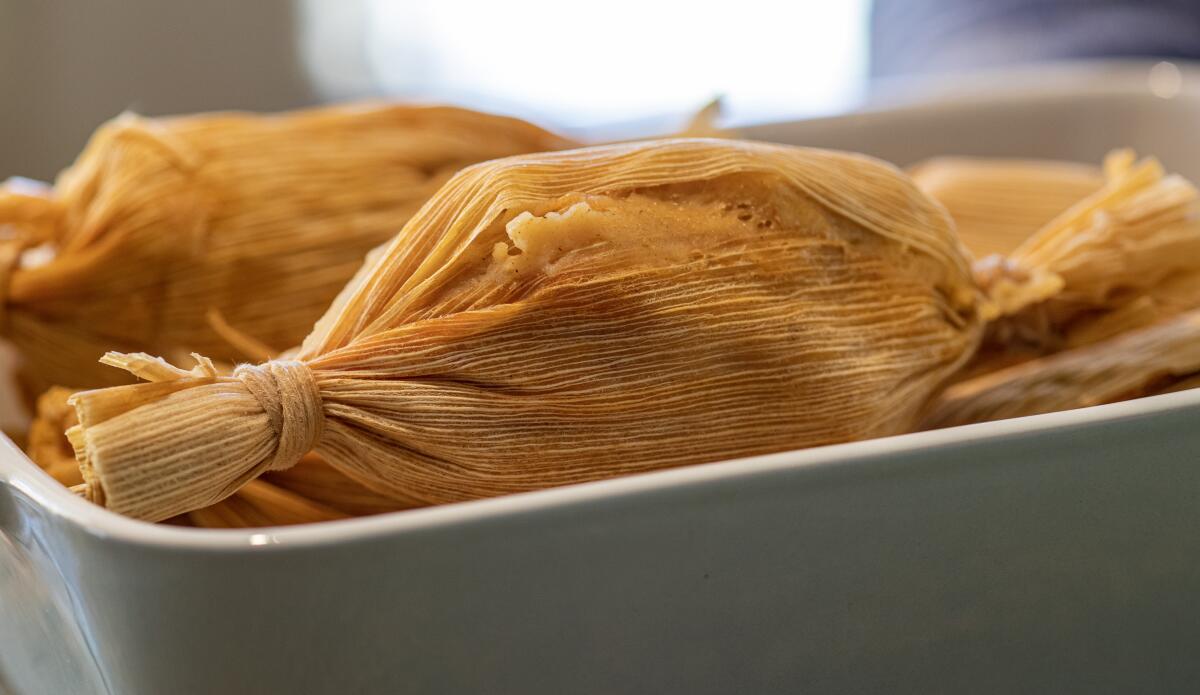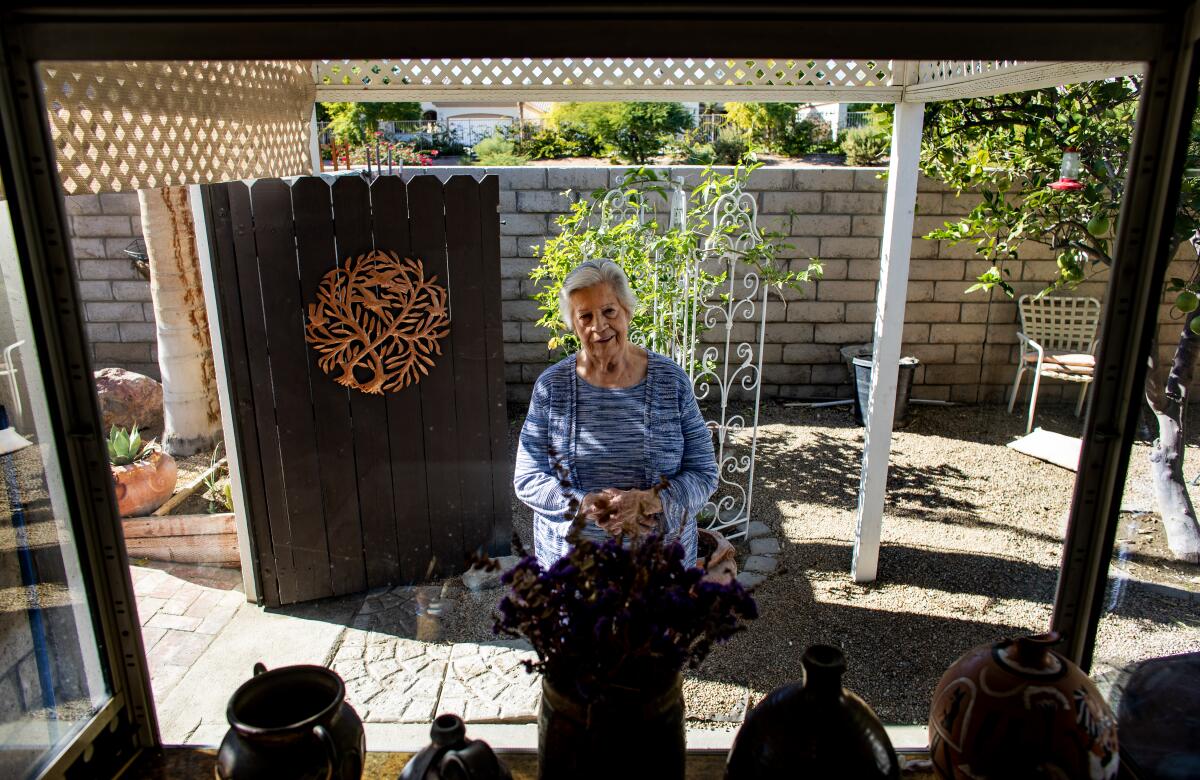Column: 30 years of masa dreams at a tamale festival in Indio

- Share via
INDIO, Calif. — When Juan Carlos Barajas was growing up in the 1990s in the Coachella Valley, the Indio International Tamale Festival was an annual treat.
It was “the thing to do,” said the 41-year-old as we drove around town. “You went, you ate, you saw some music, then you’d go again the next year.”
Barajas eventually joined his father in the restaurant industry, working as a bartender, a waiter and everything else. Neither father nor son ever thought of entering the festival — they were workers, not restaurateurs. In 2016, Barajas finally got the courage to try. He convinced his parents to set up a stall and sell his creation: a tamale, split open, with birria de res in the middle.
“My parents were first all, ‘Tamales don’t come with birria. So no one’s going to want to buy them,’” he said with a laugh. “We show up, and we sold out almost immediately. We had to call my mom to make more tamales!”

The success convinced Barajas to start a food business along with his dad. Today, their Outside the Masa truck sells birria tamales and more, from Coachella to Palm Springs, farmers markets to outside bars. They won the trophy for best tamale at last year’s Indio festival and will set up shop there again this weekend.
Outside the Masa isn’t eligible for the top prize, though. That’s because Barajas is the festival’s newly appointed culinary director. It’s his job to find the Coachella Valley’s next great tamale.
Started in 1993 with just a handful of vendors who set up tables in downtown Indio, the city-run festival is now the largest for tamales in the United States. People from across the country and beyond will descend on the desert town Saturday and Sunday to gorge on tens of thousands of tamales grabbed from steaming pots.
Unlike Indio’s other world-famous party, the Coachella Valley Music and Arts Festival, this masa madness matters far more to the day-to-day life of the region’s residents.
“Everyone comes back home, and you’re going to run into your teachers from high school and your friends from middle school,” said Indio Mayor pro tem Oscar Ortiz. “And all these mom and pops are just feeding us. If you were able to make it in the tamale festival, you can make it anywhere.”
Families are able to earn enough money for the year in just one weekend. Street sellers have opened restaurants after gaining a following here. A win in the festival’s all-important contest earns bragging rights — and the chance to level up.
“What my family was able to gain through the tamale festival,” Barajas said, “I want others to get too.”
I asked Barajas to take me to three tamaleras that showcase the festival’s kingmaking potential. We first stopped at Casa de Silvia, a small restaurant on the same street where the inaugural tamale festival took place.
Silvia Rendon sold an assortment of tamales in front of a Food 4 Less market for more than a decade until city officials drove her away. She and her family entered the tamale festival in 2015, winning first place. Two years later, they opened Casa de Silvia.
“I get goose bumps just thinking about it,” Rendon said. “I have no shame telling my story. I’m proud of it. I always tell people, ‘Sí, se puede.’”
Barajas and I forked through her tender red pork and cheese-jalapeño tamales slathered in a red salsa and dressed with crema fresca.
“These are just awesome — they’re probably the most famous tamales in the valley,” he said.
“There’s even other restaurants that have opened up that call themselves Silvia,” added Rendon’s son Isauro Jr. “I guess it’s a validation of her hard work.”
Rendon beamed as we feasted. That’s when I noticed atop a dessert case all the trophies she had won in previous Indio tamale festivals. I asked how they made her feel. She stretched out her arms.
“Like a peacock!” Rendon exclaimed. “At the end of each festival, I always say I’m not going to do it next year. And then my husband says, ‘You’re going to feel different in an hour,’ and he’s always right.”
Next up: a food commissary where Barajas parks his Outside the Masa truck. Toni Romero, who has volunteered at the tamale festival since the inaugural one, opened it in 2018 — the first commissary for food trucks in the Coachella Valley.
“You see people accomplish their dreams,” Romero said of the tamale festival, sitting at her desk. “And that motivates you to help others to make their own.”
One of her clients is Pupusas Guana Katracho’s, a Salvadoran-Honduran food truck operated by husband-and-wife team Jorge and Mercedes Murillo that reflects the cooking of their home countries. Though the two have lived in Desert Hot Springs for 15 years, they hadn’t heard about the tamale festival until organizers invited them last year.
“They told us to make 500 tamales, and I’m like, ‘Why so many? I’ll be stuck eating tamales for a full month,” Jorge cracked. “We were done by noon each day.”
This year, the Murillos plan to make 1,000 and debut a regional specialty: refried-bean tamales known as tamales pisque in Mercedes’ native El Salvador and tamal de viaje in Honduras, where Jorge is from.
Barajas unfolded the banana leaf that held Mercedes’ billowy, Salvadoran-style chicken tamale. He had never tasted one before.
“This is incredible,” Barajas said. “You don’t even need salsa for it.”

“Mexicans always want chile,” Jorge playfully shot back. “But, well, Hondurans like their tamales with ketchup.”
Our final tamale was at the well-kept La Quinta home of José Luis Suarez. There, his 89-year-old mother, Maria del Refugio Juarez — known as Mama Cuca to her family and Doña Cuca to everyone else — was waiting for us with a platter of tamales traditionally from Sinaloa, Mexico. Stuffed with carrots, meat, potatoes, onion and a solitary black olive, they rarely show up in Southern California restaurants.
This year, the tamale festival launched its “Artesano Tamaleria” program to highlight home cooks like Doña Cuca.
“There’s just so much talent out through the valley,” said Barajas. “Those abuelitas and tías — man, they’re so skillful. But a lot of them just haven’t had the chance to participate.”
Doña Cuca has lived in the region since the 1960s. Her tamales, usually made only for family and friends, are so beloved that the keepsake from her 80th birthday party was pins with tamales on them. Two were on José Luis’ refrigerator.

“Some people only make tamales for Christmas,” Doña Cuca said. “But you should always have tamales ready, because you never know who’s going to show up.”
“She’s just so happy doing this,” added her daughter Patricia. “Two years ago, she was really sick. But once she started making the tamales, it’s like life went back into her.”
Barajas and I untied the intricate knots at each end of Doña Cuca’s tamales. They were small but incredibly rich, the beneficiary of chicken stock that she mixes into her masa.
“Look at how beautiful these are!” he told her. “This takes time.”
I asked Doña Cuca how many tamales she planned to make for the Indio festival. “Only 100,” she said, then joked, “I don’t need to start a business right now.”
Before I drove back to Los Angeles, Barajas wanted to show me one last place. We returned to downtown Indio and parked at an abandoned Mexican restaurant where his father had worked decades ago. Earlier this month, Barajas closed escrow on the place and plans to open his own taqueria.
“I told my dad, who’s one of those old-school Mexican men who don’t really like to show their feelings,” Barajas said. “He was emotional. I know he was proud.”
The building was boarded up. It would need a lot of work. But Barajas was unfazed.
“All of this,” he said with a smile, “because of tamales.”
More to Read
Sign up for Essential California
The most important California stories and recommendations in your inbox every morning.
You may occasionally receive promotional content from the Los Angeles Times.











